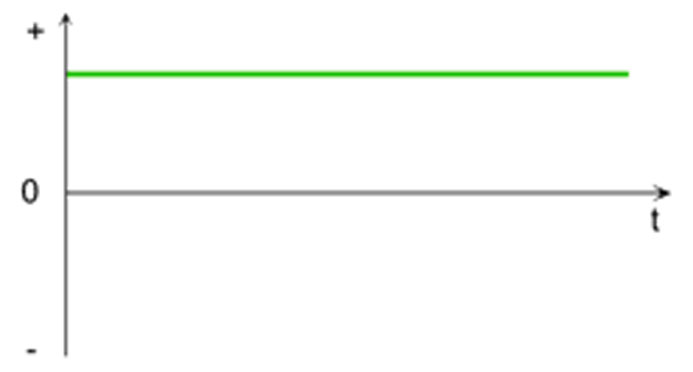What is DC or Direct current?
DC stands for Direct Current, which is electrical current that flows in one direction.
In dc circuits, the current is in one direction unlike the alternating current (AC) where the current reverses direction 50 or 60 times a second depending on the frequency of the supply. As the direct current flows, the electrons, which constitute the electric charge, flow from the point of low potential to the point of high potential. They move from the negative terminal to the positive terminal and the resulting current is in the opposite direction (from positive to negative).

Plot of direct current/voltage against time
The DC is usually used in low-voltage applications such as battery operated equipment. When a DC is required, and the use of battery is uneconomical or requires constant charging, a power supply is used to convert the ac to dc. This will charge the battery, and the equipment used off the mains until the battery is depleted (i.e. a mobile phone). The other option is to power the circuit directly from the rectified DC and have the battery work as a backup power when the AC mains supply is unavailable (i.e. in a laptop).
Power supplies range from simple regulators with one output, to smps power supplies that are more regulated and capable of supplying multiple outputs such as those required to power a computer. The voltages and current’s capacity of a power supply depend on the design and components used. There are a variety of DC voltage levels, typical values are 1.2, 1.5, 3, 3.3, 3.6, 5, 6, 10, 12, 15, 18, 18.5, 19, 20, 24, and 48 Volts.
An ideal DC supply should provide a constant voltage and adequate current throughout the operation of the equipment. However, sources such as batteries have a limited capacity and can only power the equipment efficiently for a given period determined by the rating of the battery and the load.
To maintain the power at a constant level, most equipment uses rechargeable batteries so that the charge can be replenished regularly. The charger consists of a rectifier circuit which converts the readily available AC into a suitable DC voltage.
Other than changing the mains AC to DC, most power supplies change the level of the voltage. Most of them will always lower the voltage since most of the electronics functions from much less voltage levels, but higher currents. Most laptops use between 18 Volts DC to 20 V DC and current of at least 3A. The laptop adapter must therefore provide a means of lowering the mains voltage from either the 220V or 120 Volts down to about 20 Volts DC.
Sources of direct Current
- DC generators
- Batteries
- DC power converters that rectify the AC
- Solar panels
- Thermocouples
Advantages of DC
- Most equipment are more efficient when directly powered from DC
- More efficient especially when the power leads are less than 100 feet
- Less risks of shock hazard for voltages below 48 Volts
Disadvantages of DC
- High cost when dealing with high current systems; i.e. larger cables, fuses, switches and other components required for high current, low voltage applications
- Difficult to obtain DC appliances and equipment
- Higher chances of fire hazards when maximum circuit ratings and wire sizes are not strictly adhered to
Applications
DC is used in almost all electronics equipment, electric vehicles, automation, control of electrical equipment, and more. Most office and domestic equipment such as TVs, audio systems, amplifiers, flash lights, computers, tablets and smartphones use DC power to function. However, since the universally available power is AC, the equipment uses an external or internal power supply to convert the utility mains AC into the desired DC for the equipment.